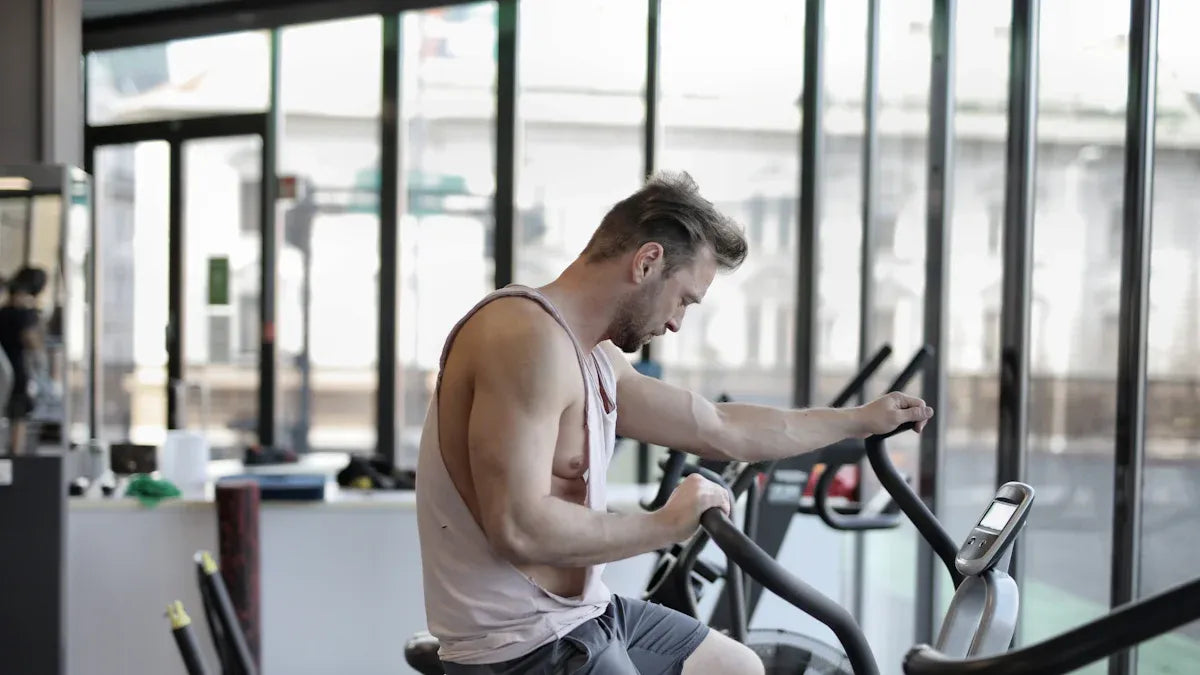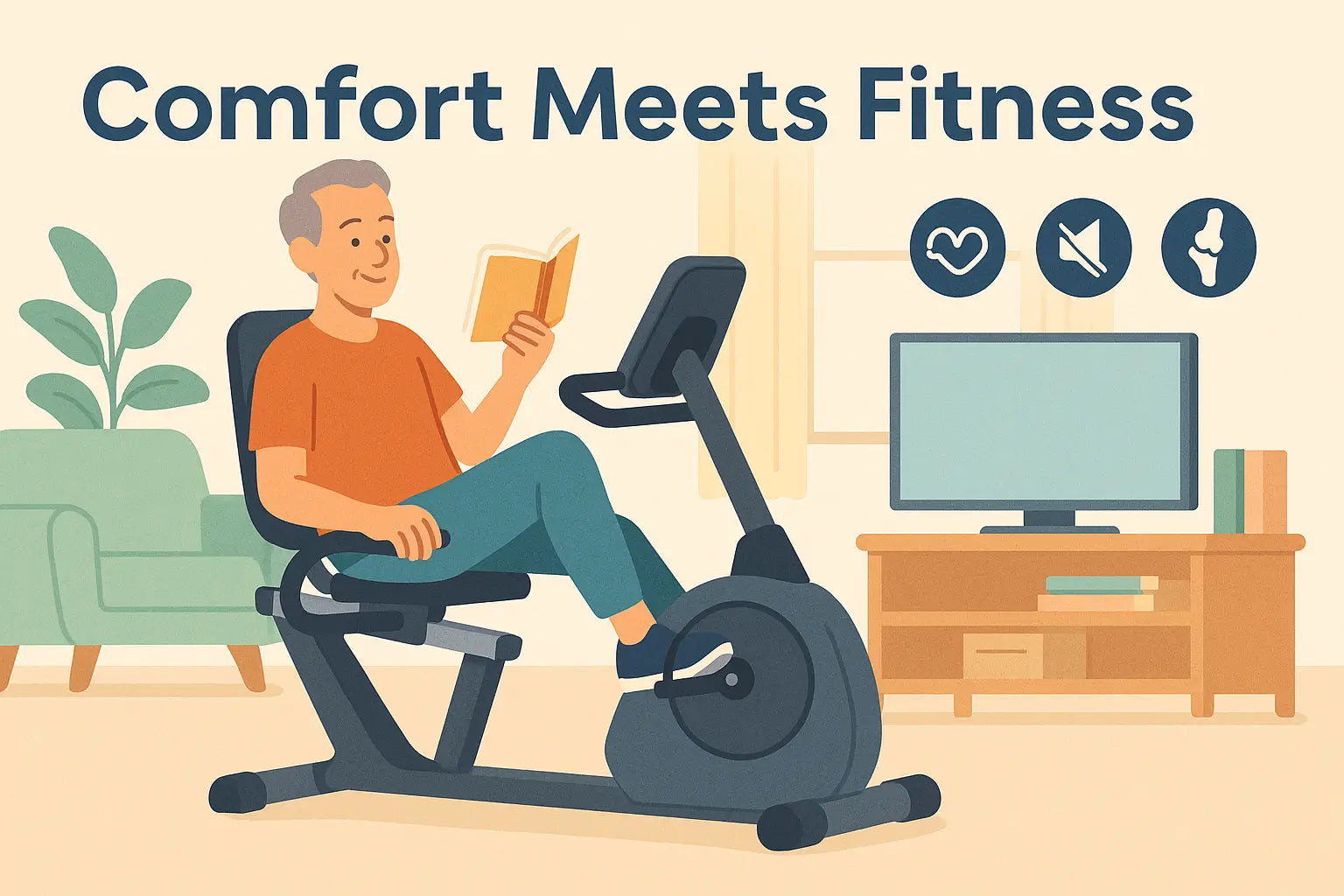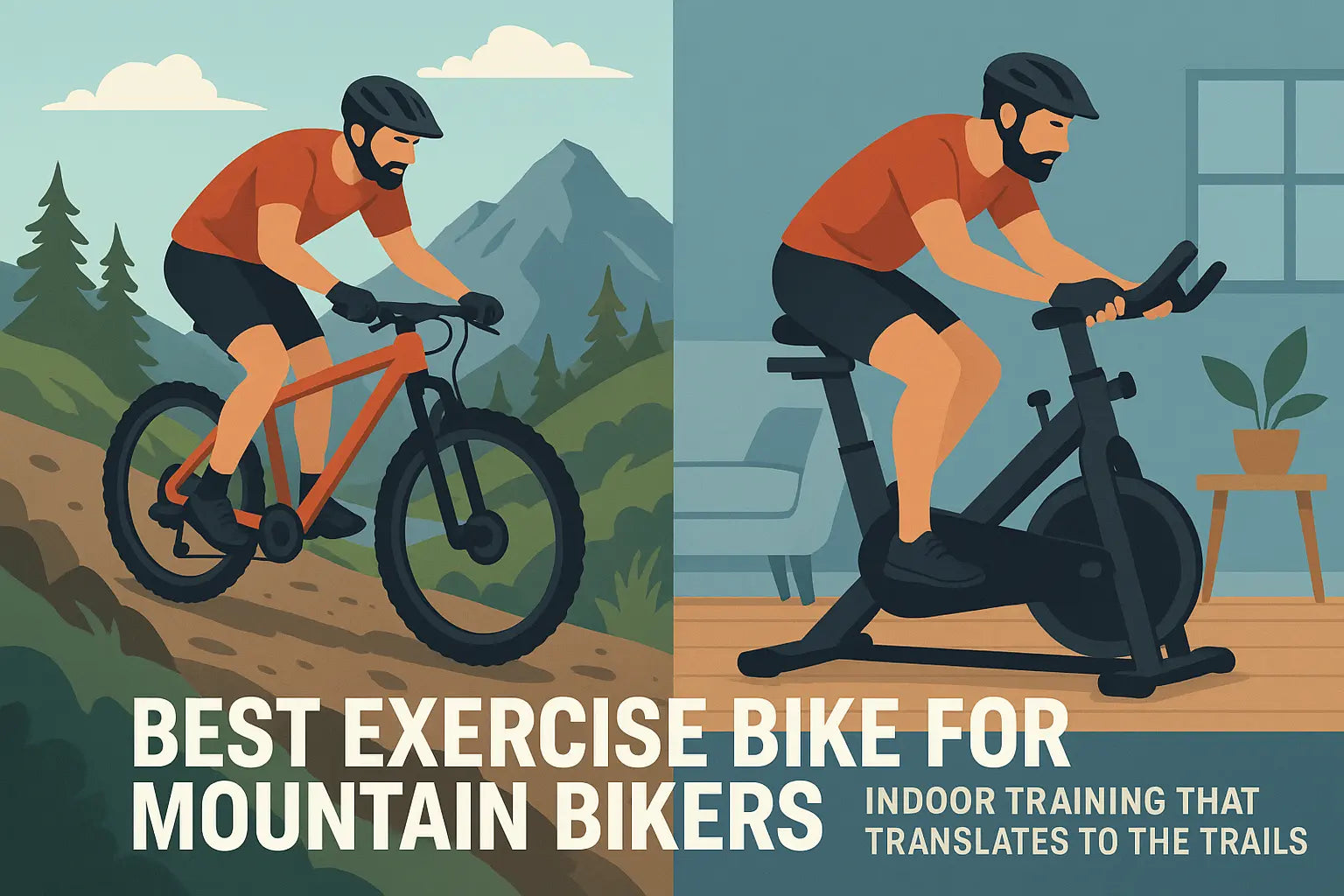You may ask if a recumbent bike helps your knees. It does not put much stress on them. It helps make the muscles near your knee stronger. Many people feel better when they use it for easy exercise. This is true if you have arthritis or old injuries. You should talk to your doctor before you start a new workout.
Key Takeaways
-
Recumbent bikes give a workout that is easy on your knees. They are good for people who have knee pain or arthritis.
-
Move the bike seat so you feel comfortable. Your knees should bend a little at the end of each pedal stroke. This helps stop your knees from getting hurt.
-
Begin with short rides. Slowly make your rides longer and harder. This helps you get stronger and keeps your knees from hurting.
Recumbent Bike and Knee Health

Low-Impact Benefits
When you deal with knee pain, you want an exercise that feels gentle. A recumbent bike gives you a low-impact workout that is easy on your joints. You sit back in a comfortable seat, and your legs move in a smooth, circular motion. This design helps you avoid the pounding and jarring that can hurt your knees during other activities.
Let’s look at how a recumbent bike compares to an upright bike when it comes to protecting your knees:
|
Benefit |
Description |
|---|---|
|
Compressive Force Reduction |
You put less pressure on your knee joint. |
|
Shear Force Reduction |
Your knees face fewer side-to-side forces, which means less strain. |
|
Joint Lubrication |
The cycling motion helps your knees stay loose and well-lubricated. |
|
Muscle Strengthening |
You build up the muscles around your knee, which helps support the joint. |
|
ACL Strain Reduction |
You lower the risk of hurting your ACL, a key ligament in your knee. |
A recumbent bike lets you get moving without making your knee pain worse. Many doctors and physical therapists recommend recumbent biking for people with knee osteoarthritis or those recovering from injuries. You can enjoy a low-impact exercise that keeps your joints healthy and helps you on your road to recovery.
Joint Support Features
You might wonder why a recumbent bike feels so much better for your knees. The answer lies in its smart design. Here are some features that make it a top choice for joint support and pain relief:
-
Low-impact pedaling: The reclined seat spreads out your weight, so your knees do not feel as much pressure.
-
Ergonomic design: The big seat and backrest keep your body in a natural position. Your knees move in a way that feels right and does not cause pain.
-
Adjustable seating: You can move the seat and pedals to fit your legs. This helps you find the best spot for comfort and safety.
-
Better stability: The bike sits low to the ground and does not tip easily. You do not have to worry about sudden movements that could hurt your knee.
People with arthritis often struggle with joint pain and stiffness. A recumbent bike helps by offering a reclined seat, a larger backrest, and pedals that sit in front of you. This setup takes stress off your knees and makes it easier to keep moving. Some bikes even have side handlebars, so your upper body stays relaxed.
Tip: If you have knee pain or knee osteoarthritis, try a recumbent bike for your next low-impact workout. You may notice less pain and more freedom to move.
Doctors often suggest recumbent biking because it reduces compressive and shear forces on your knees. It also helps your joints stay lubricated and strengthens the muscles that support your knees. Studies show that people with knee pain feel better and move more easily after using a recumbent bike.
Recumbent Biking for Knee Pain
Rehabilitation and Recovery
If you struggle with knee pain, you know how hard it can be to find an exercise that feels safe. Recumbent biking gives you a gentle way to move your legs and start your road to recovery. You sit in a relaxed position, and your knees do not have to bend as much as they do with other exercises. This makes it easier to get moving, even if you have swelling or stiffness.
-
Doctor of Physical Therapy Mike Masi explains that a recumbent bike needs less range from your hips and knees. This helps when your knee feels swollen or sore.
-
A study in the Journal of Rheumatology shows that recumbent biking can lower joint pain and stiffness. You can build muscle strength without making your knee pain worse.
-
Another study found that recumbent biking helps rehab patients with arthritis. It stretches your muscles and boosts circulation, which helps you move better and regain lost joint mobility.
You might wonder why recumbent biking works so well for pain relief. The answer is simple. The bike supports your body and lets you pedal without putting too much force on your knees. You can start slow and increase your time as you feel stronger.
Tip: If you are recovering from knee surgery, try adjusting the seat on your recumbent bike. Move it back from the pedals to help your knee make a full rotation. As your range of motion improves, bring the seat closer. Some people find it easier to pedal backward until they can pedal all the way around.
Recumbent biking helps you strengthen the muscles around your knee. Strong muscles support your joint and keep it stable. This makes it easier to walk, climb stairs, or do daily tasks. You do not have to worry about sudden movements or losing your balance.
"Recumbent cycling shows greater gastrocnemius activity, which means it helps you build leg muscles. The simple movement and low postural demands make it a great choice for rehab, especially if you have limited mobility."
Improving Range of Motion
You want to keep your knees moving, even when you have knee pain. Recumbent biking helps you do just that. The bike lets you pedal in a smooth, horizontal motion. This feels easier on your knees than upright bikes or walking.
-
Recumbent biking is non-weight bearing. You do not put extra stress on your bones or joints.
-
It works well for people with arthritis, joint pain, or osteoporosis.
-
The horizontal pedal stroke feels more comfortable on your knees.
-
You do not need to bend your knee as much, and you avoid high peak forces.
Here is a quick look at how recumbent biking compares to other exercises for improving range of motion:
|
Exercise Type |
Knee Flexion Needed |
Joint Stress |
Comfort Level |
Safety for Knee Pain |
|---|---|---|---|---|
|
Recumbent Biking |
Low |
Low |
High |
Excellent |
|
Upright Biking |
Moderate |
Moderate |
Moderate |
Good |
|
Walking |
Moderate |
Moderate |
Moderate |
Fair |
|
Running |
High |
High |
Low |
Poor |
When you use a recumbent bike, you change the forces on your knee. The bike reduces the load on your ACL and helps you move your knee through a safe range. You can stretch your muscles and improve your joint mobility without making your knee pain worse.
Note: Recumbent biking helps you stay active, even if you have common causes of knee pain like arthritis or old injuries. You can enjoy pain relief and keep your knees moving.
Recumbent biking gives you a safe way to work on your range of motion. You can start slow, listen to your body, and build up your strength. Over time, you may notice less knee pain and more freedom to move.
Recumbent Bike for Knee Osteoarthritis
Exercise Safety
You want to feel safe when you exercise with knee osteoarthritis. A recumbent bike gives you that peace of mind. The seat supports your back, and your feet stay steady on the pedals. You do not have to worry about falling or sudden movements. Doctors and clinical guidelines say cycling is a smart choice for people with knee osteoarthritis. It is gentle, does not put weight on your joints, and helps you move without pain.
Here is what experts found about safety and benefits:
|
Outcome |
Description |
|---|---|
|
Knee Pain Reduction |
You can lower pain in your knee with regular recumbent biking. |
|
Joint Health Support |
Your joints get stronger and stay healthy. |
|
Reduced Knee Strain |
The bike design lowers stress on your knee, especially the ACL. |
Many studies show that bicycling is linked to less knee pain and better joint health. You can trust this exercise to help you feel better and stay active.
Comfort and Accessibility
Comfort matters when you have knee osteoarthritis. The recumbent bike makes workouts easier. The seat leans back and gives your back support. You can ride longer without feeling sore. The pedals sit in front of you, so your knees do not bend too much. This helps you avoid pain and stiffness.
People with knee osteoarthritis often need a safe and easy way to exercise. The recumbent bike offers stability and keeps you from slipping. Seniors and those with mobility problems find it easy to get on and off. You can adjust the seat and pedals to fit your body.
Here is a simple plan for exercise:
|
Day |
Activity |
Duration |
|---|---|---|
|
Tuesday |
Bike |
|
|
Friday |
Bike |
20 minutes |
|
3 months later |
Bike |
45 minutes |
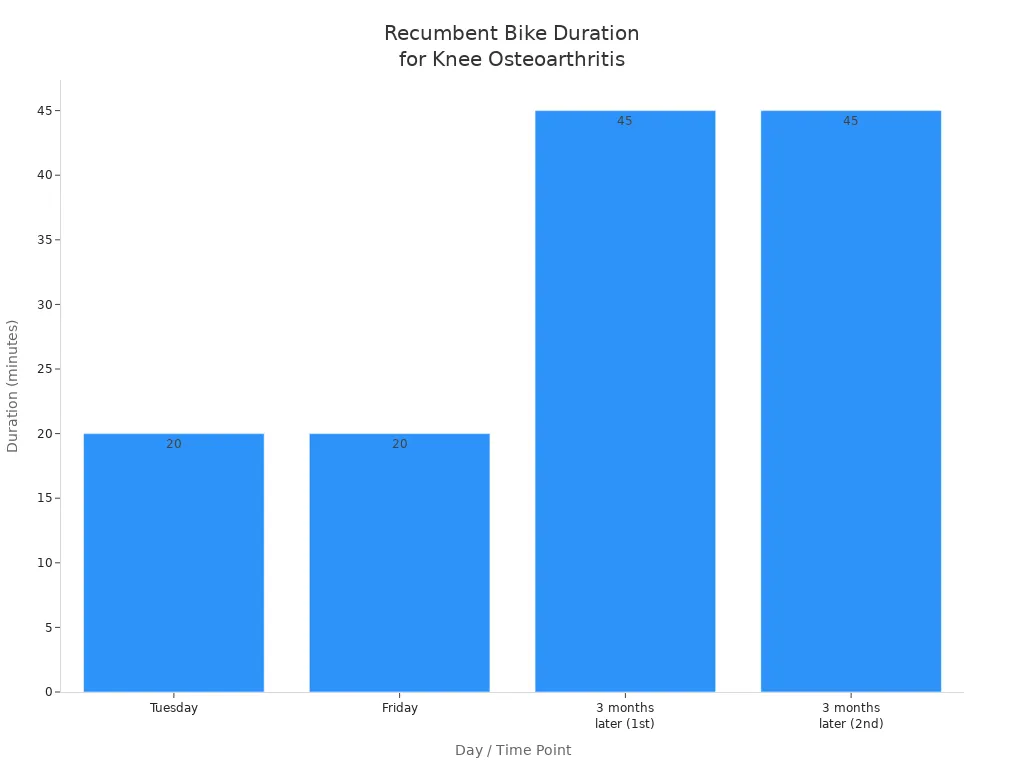
You can start with short rides and slowly build up your time. The comfort and easy setup help you stick with your exercise plan. You may notice less pain and more movement in your knee.
Practical Tips for Safe Recumbent Biking
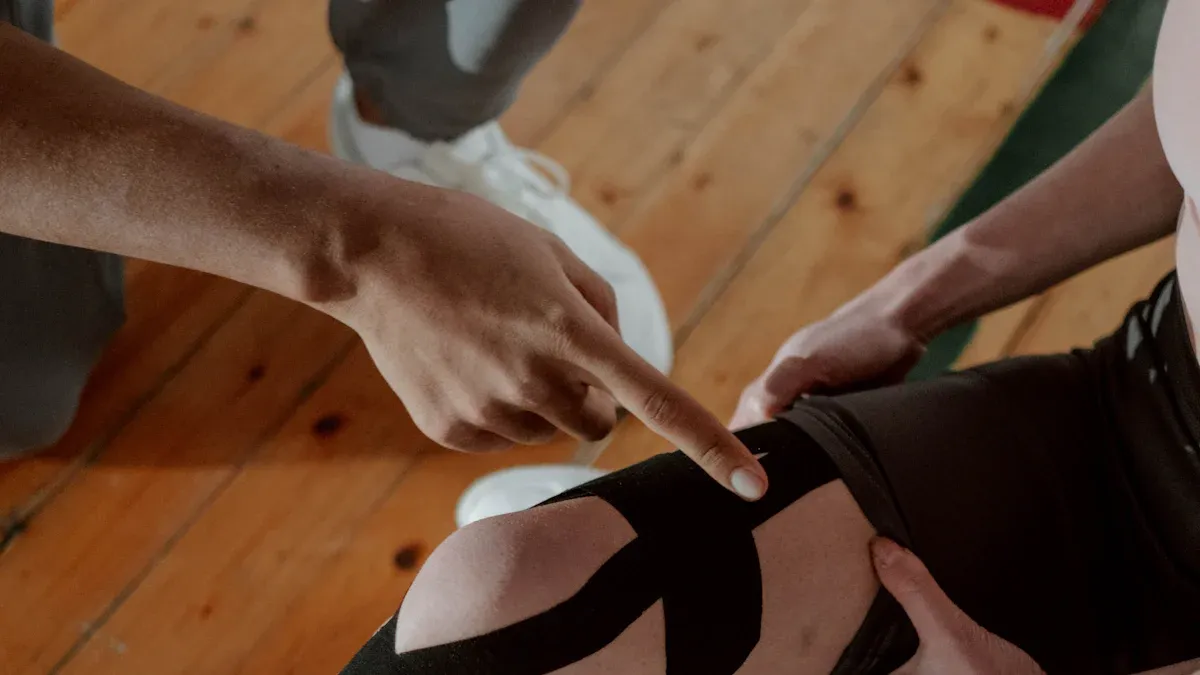
Proper Setup
Getting your recumbent bike ready is the first step on your road to recovery. You want to set the seat so your knees have a slight bend when your foot reaches the farthest point on the pedal. If your legs stretch out too much, you might feel pain or strain. Try to keep your knee at about a 25-30 degree bend at the end of each pedal stroke. Place the ball of your foot right over the center of the pedal at the 3 o’clock position. This setup helps you avoid overextension and keeps your ride smooth.
Proper saddle height is crucial for knee health. If the seat is too low, your knees bend too much and may hurt. If it’s too high, you risk stretching your knees too far. Adjust the seat so your knee stays at about 30 degrees of flexion when the pedal is at its lowest point. Take a short test ride to check for comfort and pain.
Gradual Progression
You might feel excited to start, but slow and steady wins the race. Begin with short sessions and low resistance. Increase your time and intensity little by little. People who bike regularly have less knee pain and a lower chance of osteoarthritis. Building up your strength over time helps your joints stay healthy. Avoid jumping into long rides or tough workouts right away.
Here’s a simple plan to follow:
|
Week |
Session Length |
Resistance Level |
|---|---|---|
|
1 |
10 min |
Low |
|
2 |
15 min |
Low-Medium |
|
3 |
20 min |
Medium |
Monitoring Knee Health
Pay attention to how your knee feels during and after each ride. Use your glute muscles while pedaling to protect your knees. If you notice more strain in your quads than glutes, you might want to try an upright bike instead. Watch for signs of pain, swelling, or stiffness. If you feel discomfort, stop and rest.
Common mistakes to avoid:
-
Using high gears or low cadences strains your knees.
-
Rapidly increasing riding time can cause injury.
-
Setting the seat too low causes excessive knee bending.
Tip: Always listen to your body. If you have a knee condition, talk to your doctor or physical therapist before starting. They can help you find the best setup and plan for your needs.
Regular biking helps strengthen your knee muscles and ligaments. Adjustable resistance lets you build strength safely. Controlled sessions improve your range of motion and reduce stiffness. Staying aware of your comfort and progress keeps you moving forward on your road to recovery.
You get a gentle workout that helps your knee feel better. Recumbent bikes support your joints and make exercise safe for arthritis or pain.
-
Adjust the seat for comfort.
-
Start slow and listen to your body.
Talk to your doctor if your knee hurts. Enjoy moving with less pain and more confidence!
FAQ
Can you use a recumbent bike if you have knee arthritis?
Yes, you can. Recumbent bikes offer gentle movement and support. You may feel less pain and more comfort during exercise.
How often should you ride a recumbent bike for knee health?
You can start with two or three sessions each week. Try short rides first. Increase your time as your knees feel stronger.
Do recumbent bikes help build leg muscles?
Yes! You work your thighs, calves, and glutes while pedaling. Stronger muscles help support your knees and improve your movement.
Latest Articles




